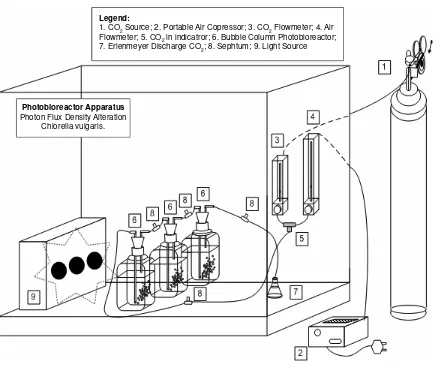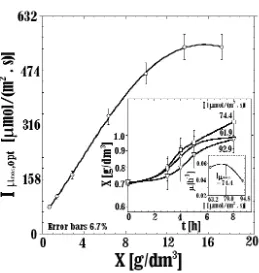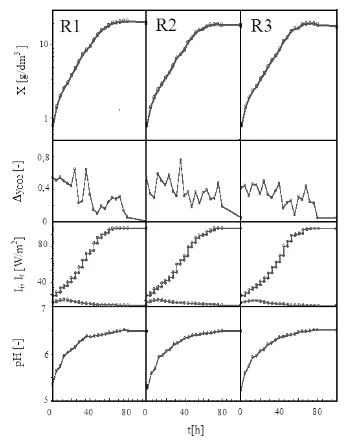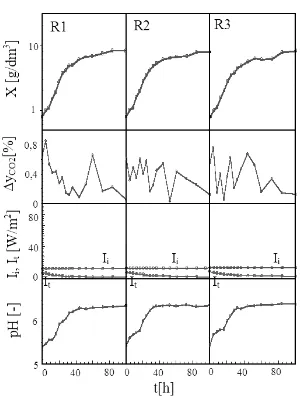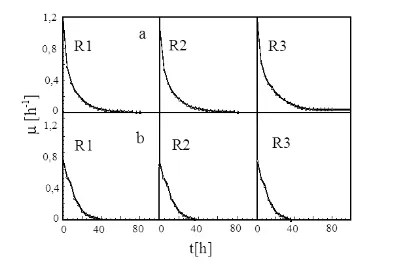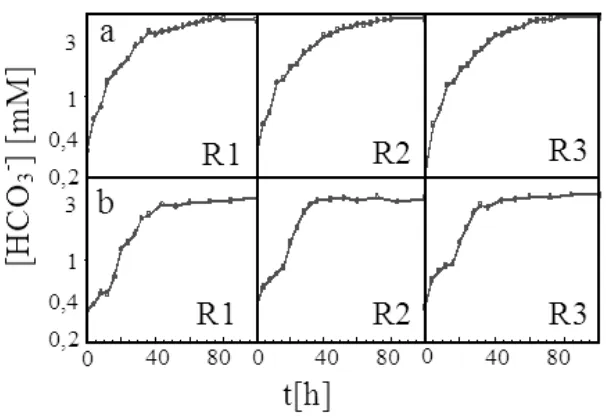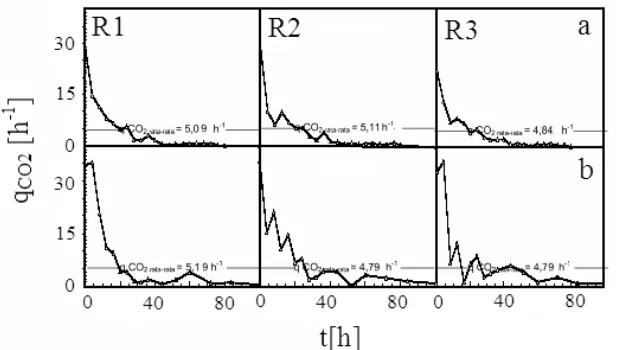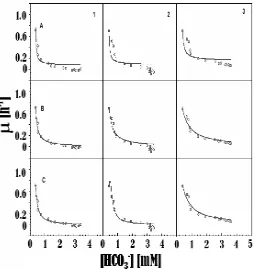Enhanced
Chlorella vulgaris
Buitenzorg
growth by Photon Flux Density Alteration
in Serial Bubble Column Photobioreactors
Anondho Wijanarko
Dianursanti Antonius Yudi Sendjaya Misri Gozan
Roekmijati Widaningroem Soemantojo
Department of Chemical Engineering, Faculty of Engineering, The University of Indonesia
Kampus Universitas Indonesia, Depok 16424, INDONESIA
Arief Budi Witarto
Biotechnology Research Center, Indonesian Institute of Science, Jalan Raya Bogor KM 46,
Bogor 16911, INDONESIA
Kazuhiro Asami Kazuhisa Ohtaguchi
Department of Chemical Engineering, Tokyo Institute of Technology, 2-12-1 Ookayama,
Meguro ku, Tokyo 152, JAPAN
Micro algae are photolitotrophs that perform oxygenic photosynthesis and capable of accumulating a large amount of CO2, using an inducible CO2 concentrating mechanism (CCM). These characteristics make the micro algae potentially useful for removal and utilization of CO2 emitted from industrial plant. Generally, the usage of photosynthetic microorganism in CO2 fixation and biomass production for the economically viable commodities have been increased and significantly improved as a solution for this problem. Using these facts and previous research results using Anabaena cylindrica IAM M1 and Spirulina platensis IAM M 135, enhancement of CO2 fixation and biomass production by Chlorella vulgaris Buitenzorg with photon flux density alteration along with an increasing of culture biomass during the cellular growth period, was implemented in this research. The photon flux density used in this alteration was the maximum light for Chlorella’s maximum growth rate (
opt
I
max,m ). The cultivation of Chlorella
vulgaris Buitenzorg in the Benneck basal medium operating conditions: T, 29oC; P, 1.0 atm; UG, 2.4m/h; CO2, 10%; using Philip Halogen Lamp 20W/12V/50Hz as the light source and three bubble column photobioreactors arranged in series order with each having a volume of 0.200dm3. Results had shown that the photon flux density alteration as a whole could increase around 60% the biomass production of Chlorella vulgaris and around 7% the CO2 fixation ability, compared to constant photon flux density outcomes. This experiment also showed that the noncompetitive inhibition of [HCO3-] as carbon source substrate is affected significantly during the cultivation in both of alteration and continuous photon flux density.
Keywords: Biomass, Chlorella vulgaris Buitenzorg, alteration, photobioreactor, seri
Paper10.indd 89
INTRODUCTION
Micro algae are photolitotrophs that perform oxygenic photosynthesis. Like higher plants, these organisms require radiant energy using water as an electron donor and represent significant contribution to eliminate atmospheric greenhouse gas carbon dioxide (CO2) by ribolose bisphosphate carboxylase/ oxygenase (RubisCO). The reduced products of CO2 serve as the carbon source for the entire biomaterial. In addition, micro algae are capable of accumulating a large amount of CO2, using an inducible CO2 concentrating mechanism (CCM) [Kaplan, Bdger, and Berry1980]. Previous study has shown that when micro algae
Synechococcus leopoliensis IAM M6 was grown
on the modified Detmer medium (MDM) at 313K, it accumulated external inorganic carbon (ci = CO2 + HCO3-) to the extent of 0.128 g.L -1.h-1 that was a five- to nine-fold higher than the CO2 fixation rate of photosynthesis (Ohtaguchi, 2000). These characteristics make the micro algae potentially useful for study on the removal and utilization of CO2 emitted from industrial plant to minimize the accumulation of carbon dioxide in nature. Generally, the usage of photosynthetic microorganisms Anabaena cylindrica, Chlorella
vulgaris, Synechococcus leopoliensis, and
Spirulina platensis in CO2 fixation and biomass
production for economically commodities such as has been increased and significantly improved; as a solution for this problem [Ohtaguchi and Wijanarko 2002; Wijanarko, Asami, and Ohtaguchi 2004a; Wijanarko and Ohtaguchi, 2004b].
Chlorella biomass is widely known as a high-potential substance with high economic values, such as chlorophyll, CGF, beta-carotene, protein and cell walls (Wirosapurto 2002). For its growth, Chlorella needs light energy and substrates. Light energy is an important factor for Chlorellagrowth that would be converted to ATP synthesizes for use in their photosynthesis, metabolism, growth, and cell division. Either,
the CO2 as Chlorella substrate was fixated and used with the ATP synthesize in dark reaction to produced carbon compound (Ogbonna, 1995). Unfortunately, the results of CO2 fixation and biomass production with constant photon flux density were relatively small, because the effect of self-shading phenomenon and the needs of light energy’s increasing during microbial growth were considered as being slight [Falkowsky and Owens 1980; Oquist et al. 1992].
Using to these facts and the previous research results using A. cylindrica IAM M1
and S. platensis IAM M 135 (Wijanarko and
Ohtaguchi 2003; Hirata, Taya, and Tone 1996, 1998], an enhancement effort of CO2 fixation and biomass production by C. vulgaris
Buitenzorg with photon flux density alteration along with an increasing of culture biomass during cellular growth period was implemented in this research. The photon flux density used in this alteration was the maximum light for Chlorella’s maximum growth rate
opt
I
max,m .
This experimental report also contained the investigation results about the kinetic studies of microbial growth.
MATERIALS AND METHODS
C. vulgaris Buitenzorg was supplied from
the Depok Research Center of Fresh Water Fishery, Indonesia. This strain was cultivated in a serial configuration of 0.200 dm3 bubble column photo bioreactor (0.08m inside (s), Pyrex glass made) using Benneck basal medium at T, 290C; P, 1 atm; and, Q
G., 25.4 dm 3/h. The inlet CO2 composition enriched air yCO2,i
was set around 10% and illuminated by side illumination at 14.9W/m2 (74.4 μmol/[m2 s]) simultaneously until 103W/m2 (542 μmol/[m2s]) refers to the increasing of biomass production at cultivation period with Philip Halogen lamp 20W/12V/50Hz. Cultivation at constant photon flux density (Ii) of 14.9W/m2 (74.4μmol/[m2 s]) was also performed as control experiment. Benneck was chosen as the medium since
Paper10.indd 90
it has a simple composition without carbon source and common nutrition for C. vulgaris’s development. Preculture conditioning was done in the beginning by feeding the air into the reactor and with the photon flux density at 2,95 W/m2 (14.7 μmol/[m2 s]) in order to pass the lag phase of C. vulgaris’s growth. The photon flux density alteration performed a change of distance between one side of the photobioreactor and the parallel banks of halogen lamps as illumination source as shown in Figure 1.
Measuring OD600 of cell suspensions was performed for the growth analysis. The calibration curve is used to show that the value of OD600 is equivalent to the dry weight concentration. The CO2 concentration of input and output gas (yCO2,i
, yCO2,e) was performed by gas chromatography
(GC TCD Shimadzu GC-8A). The photon flux densities of the incident and transmitted light were measured by Lux meter (Luxtron LX-103) and the pH of the cultures was measured using pH meter (Hanna Model HI 8014). Data
Figure 1. Experimental Apparatus
Legend:
1. CO2 Source; 2. Portable Air Copressor; 3. CO2 Flowmeter; 4. Air Flowmeter; 5. CO2 in indicatror; 6. Bubble Column Photobioreactor; 7. Erlenmeyer Discharge CO2; 8. Sephtum; 9. Light Source
Photobioreactor Apparatus
Photon Flux Density Alteration Chlorella vulgaris.
Paper10.indd 91
obtained from the experiment is processed to find several parameters as follows:
1. Biomass Amount (X)
The amount of cell biomass can be obtained using the calibration curve OD680 vs X.
2. The specific growth rate and incident specific growth rate (μmax, μ) is calculated using the Monod’s equation (Monod, 1942) as follow
μ= 1 dX
X dti (1)
3. The carbon dioxide transfer rate (CTR) and specific carbon dioxide transfer rate (qCO2) is calculated using the following equation:
CRT = yco
4. The bicarbonate concentration ([HCO3-]) is calculated using Handerson-Hasselberg’s equation as follows:
Here, KCO2,o and HCO2,o are equilibrium and Henry constant at 25oC and 1.0 atm., y
CO2 is
ambient CO2 concentration at ambient air, PT is ambient pressure, pH is incident culture pH value.
AK, BK, and CK are thermodynamic equilibrium constant parameters while AH, BH, and CH are thermodynamic Henry constant parameters.
5. The light energy utility for biomass production (Ex) was calculated by the following equations:
Three equations of kinetic models were used to investigate the microbial growth model in this research as a substrate inhibition model (Bailey and Ollis 1986; Schugerl and Belgardt 2000), such as:
b. Ierusalemsky
μ=μmax 3
Paper10.indd 92
Here Ki and Ks are the inhibition and activation substrate constants.
RESULTS AND DISCUSSION
General Discussion
The biomass concentration used for initial running in each photobioreactor arranged in serial configuration is 0.81 g/dm3 of dry weight. This amount is an ideal low concentration that makes it have a possible to obtain a high specific growth rate. Cultivation started when the CO2 gas flow was opened at a concentration of 10%. In the beginning of cultivation, the photon flux density given to the reactor was 14.9 W/ m2 (74.4 μmol/[m2 s]). This is the optimum photon flux density (Iμ max,opt) for the cultivation
of C. vulgaris which has biomass concentration
was 0.81 g/dm3. Then, the photon flux density is increased during the cultivation period based on the amount of biomass inside each
photobioreactor. The photon flux density given to each reactor was based on the curve showing the relationship between the dry weight of cell (X) and the optimum photon flux density (Iμ
max,opt) shown in Figure 2.
Experimental Data
From the cultivation of Chlorella
vulgaris Buitenzorg in a serial bubble column
photobioreactors with photon flux density alteration, the data is being shown out in Figure 3.
Meanwhile the control experiment results are shown in Figure 4.
Effect of Photon Flux Density Alteration to the Biomass Production of C. vulgaris
Buitenzorg
Effect onto cellular dry weight (X). With the similar initial cellular dry weight of 0.81 Figure 2. Relationship between X and Iμ max,op of C. vulgarisBuitenzorg.
Compared data is obtained from cultivation of C. vulgaris in the continuous photon flux density of 74.4 μmol/[m2s] (14,9 W/m2).
Paper10.indd 93
Figure 3. Experimental results on photon flux density alteration during cell cultivation in serial bubble column photobioreactors
g/dm3, it was found that the growth curve’s slope of C. vulgaris Buitenzorg is sharper in the photon flux density alteration compared with the constant photon flux density. This phenomenon happened in all of the photobioreactors in the serial configuration. The final biomass production result was tended by cellular dry weight after the cultivation entered the stationer phase as shown in Table 1.
Table 1. Final Cellular Dry Weight
Photon Flux Density Reactor No. X (g/dm3)
ALTERATION
1 21.5
2 19.5
3 20.0
CONSTANT
1 8.2
2 7.8
3 8.2
Paper10.indd 94
From Table 1, it is shown that the final biomass production results on the photon flux density alteration were more than the results on the constant photon flux density. These results tend that the photon flux density alteration was able to raise the cultivation of C. vulgaris
Buitenzorg in biomass production by up to 60%. Hence, the photon flux density alteration based on cellular photosynthetic activation needs can reduce the self-shielding effect in dense cellular dry weight condition.
Effect onto the specific growth rate (μ).
The values of specific growth rate (μ)during the
Figure 4. Control Experiment Results by Constant Photon Flux Density during Cell Cultivation in Serial Bubble Column Photobioreactors
cultivation with photon flux density alteration and constant photon flux density are shown in the Figure 5.
Like the results of previous experiments (Wijanarko and Ohtaguchi 2003, Wijanarko et al. 2006), Figure 5 shows that photon flux density alteration increases the specific growth rate of the micro algae in the serial bubble column photobioreactors. This result was directly impacted to the amount of produced biomass.
Effect onto [HCO3-]. The culture’s [HCO
3 -] showed the amount of formed bicarbonate ions during cellular CO2 fixation that was consumed
Paper10.indd 95
by Chlorella vulgaris Buitenzorg during cellular growth. [HCO3-] is calculated from the changing of the culture’s pH as a result of the CO2 fixation and of the cell growth activity of C. vulgaris
Buitenzorg.
The carbon dioxide gas’s entering the culture and hydrolyzing with water to form a bicarbonate ion was based on Eq. (10).
CO2
⎯
+⎯ →
H⎯
2O HCO 3- + H+ (10)
During the cellular growth period, C.
vulgaris Buitenzorg cells consumed bicarbonate
ion and ,together with another culture’s essential substrates, was metabolized by enzymatic reaction to form cellular building block organic compounds, such as: amino acid, fatty acid, glucose, sucrose, amylum, cellulose, lignin, protein, fat, and oligo-protein.
Eq. 11 showed an overall enzymatic cellular HCO3- consumed reaction of C. vulgaris Buitenzorg to form glucose.
H2O+HCO3-
⎯
Chlorella⎯
⎯
⎯
.→
6
1
C6H12O6+O2+OH- (11)
Using the approximation of Henry’s Law and Hendersen-Hasselbach equation, the HCO3 -concentration could be found from experimental pH data. Figure 6 shows the experimental HCO3 -concentration of C. vulgaris Buitenzorg.
Because of intracellular growth activity, the culture pH increased and was directly impacted to the increased culture’s [HCO3-]. Figure 6 shows that, at the end of running period, in each bubble column photobioreactor the photon flux density alteration mode provided 4.5mM of [HCO3-], while the constant photon flux density mode tended 3.5mM. Thus, it was shown that the photon flux density alteration mode could enhance the culture’s bicarbonate concentration up to 30%.
Effect of Photon Flux Density Alteration to
C. vulgaris Buitenzorg’s CO2 Fixation
CTR showed the amount of transferred CO2 gas to the culture medium during the cellular growth period. Figure 7 shows both of the CTR experimental results. Figure 7 shows Figure 5. Specific Growth Rate (μ) Results in Serial Bubble Column Photobioreactors on
(a) photon flux density alteration; and (b) constant photon flux density
Paper10.indd 96
that the average value of CTR of the photon flux density alteration (14.4 g/[dm3.h], equal to 1.38 tons CO2/[ha.d], for a pond that has a maximum light path length of 40cm) is higher than the constant photon flux density (13.8 g/[dm3.h], equal to 1.30 tons CO2/[ha.d]). Like the result for cellular day weight, the photon flux density alteration mode enhanced the value of CTR only up to around 5%. Compared with up to grass plants, such as Mimosa (0.133 tons CO2/[ha.d]),
C. muconoides (0.121 tons CO2/[ha.d]), and
Centronema (0.296 tons. CO2/[ha.d]), the CO2
fixated capability of C. vulgaris Buitenzorg in both photon flux density alteration and constant photon flux density is extremely higher than any of those plants capability (Widjaja 2002).
The qCO2 showed the incident specific CO2 fixation rate that was caused by biological activities during the cellular growth period. The value of qCO2 can be defined as CTR divided by Figure 6. Cellular [HCO3-] in Serial Bubble Column Photobioreactors
on (a) photon flux density alteration and (b) constant photon flux density
Figure 7. CTR values in serial bubble column photobioreactors on (a) photon flux density alteration; (b) constant photon flux density.
Paper10.indd 97
the cellular dry weight. Figure 8 shows the two qCO2 experimental results.
Figure 8 shows that the average value of qCO2 of the photon flux density alteration (5.01 h-1) is slightly higher than the constant photon flux density (4.92 h-1) and that the photon flux density alteration mode enhances the value of qCO2 only up to around 1%.
Energy for Biomass Production of C. vulgaris
Buitenzorg.
Table 2 shows the calculated amount of utilized energy, which was used in the biomass production of C. vulgaris Buitenzorg.
Table 2. Energy for Biomass Production of C. vulgarisBuitenzorg
Photon Flux Density Reactor No. Ex (J/g)
ALTERATION
Like in the results of previous experiment (Wijanarko et al. 2006), the value of average utilized energy on the photon flux density alteration mode is lesser than on constant photon flux density. The Ex on the photon flux density alteration is around 40% of the value on the constant photon flux density.
Kinetics Model of Cellular Substrate Consumption
Using the culture’s [HCO3-] as essential substrate for cellular growth, the kinetics curve fitting of Monod, Ierusalemsky, and Haldane model equation approximation was carried out. This curve fitting is the method to figure out the matched model approximation which was able to describe the substrate consumption during the cultivation period. Figure 9 shows a matched model approximation curve fitting for the photon flux density alteration mode and Figure 10 for the constant photon flux density mode.
Although both the photon flux density alteration and the constant photon flux density modes showed that the activation and inhibition growth model of the Ierusalemsky and Haldane equations have a relatively similar tendency. With reference to the previous experimental model results for filamentous cyanobacterium Figure 8. qCO2 Values in Serial Bubble Column Photobioreactors
on (a) photon flux density alteration and (b) constant photon flux density.
Paper10.indd 98
Figure 9. Curve Fitting Result of Model Approximation of (a) Monod (b) Ierusalimsky, and (c) Haldane for Photon Flux Density Alteration
Figure 10. Curve Fitting Result of Model Approximation of (a) Monod; (b) Ierusalimsky, and (c) Haldane for Constant Photon Flux Density
Paper10.indd 99
Anabaena cylindrica Lemmerman on photon flux density alteration and using both single and serial reactors at low photon flux density of 1.0klx (Wijanarko and Ohtaguchi, 2003, 2004) and for unicellular green algae C. vulgaris Buitenzorg on photon flux density alteration in a single reactor at ambient temperature (Wijanarko et al. 2006), the Haldane equation is properly matched to the cellular growth kinetic of C. vulgaris Buitenzorg on both photon flux density alteration and constant photon flux density in a serial reactor. This means that in both modes carbon source significantly affects in the competitively inhibition mechanism of Haldane.
CONCLUSION
Alteration of light ilumination in Chlorella
vulgaris Buitenzorg cultivation can increase the
biomass production (X) by 60% higher than biomass production in continous ilumination when photon flux density is Iμmax,opt at the basic inoculum.
The capacity of C. vulgaris Buitenzorg for CO2 fixation slightly increases to around 5% with that in photon flux density alteration compare to the constant photon flux density.
The utilized energy for biomass production
of C. vulgaris Buitenzorg on the photon flux
density alteration is less than constant photon flux density, by around 40% of the value of constant photon flux density.
The kinetics equation model of Haldane is most satisfactory for biomass production on both photon flux density alteration and constant photon flux density. It means that in both modes, carbon source is significantly affecting in the competitively inhibition mechanism.
ACKNOWLEDGEMENT
The authors thank the reviewers and editors for their useful comments on this paper. This work was supported in part by 13th Competitive Grant for Scientific Research of the Directorate General of
Higher Education, Ministry of National Education, Republic of Indonesia.
REFERENCES
Bailey, J.E. and Ollis, D.F. (1986), Biochemical
Enginering Fundamental, McGraw Hill
Book Co., New York Ch.7, 382-392. Falkowsky, P.G. and Owens, T.G. (1980), “
Light-Shade Adaptation,” Plant Physiology, 66,
592-595.
Hirata, S., Taya, M. and Tone, S. (1996).” Characterization of Chlorella cell cultures in batch and continuous operations under a photoautotrophic condition,” Journal of Chemical Engineering of Japan, 29, 6, 953-959.
Hirata, S., Taya, M. and Tone, S. (1998). “ Continuous cultures of Spirulina platensis
under photoautotrophic conditions with change in light intensity,” Journal of Chemical Engineering of Japan, 31, 4, 636-639.
Kaplan A., Badger, M.R. and Berry, J.A. (1980), “ Photosynthesis and the intracellular inorganic carbon pool in the blue green alga
Anabaena variabilis: Response to external
CO2 concentration,” Planta, 149, 219-226.
Monod, J. (1942), Recherche sur la croissance des cultures bacteriennes. Herman and Cie, Paris, 211-232.
Ogbonna, J. C., Yada, H. and Tanaka, H. (1995). “Kinetics study on light-limited batch
cultivation of photosynthetic cells” , Journal
Fermentation and Bioengineering, 80, 7, 259-264.
Ohtaguchi, K. (2000). “ Soft energy path synthesis from carbon dioxide to biofuel ethanol through cyanobacterial biotechnology,” Technology, 7S, 175-188.
Ohtaguchi, K. andWijanarko, A. (2002). “Elevation of the efficiency of cyanobacterial carbon dioxide removal by monoethanolamine
solution,” Technology, 8, 267-286.
Paper10.indd 100
Oquist, G., Anderson, J.M., McCaffery, S. and Chow, W. S. (1992). “ Mechanistic difference in photoinhibition of sun and shade plants,”
Planta, 188, 422-431.
Schugerl, K. and Bellgardt, K.H. eds. (2000).
Bioreaction Engineering Modeling and
Control, Springer, Berlin.
Widjaja, H. (2002). Penyimpanan karbon dalam
tanah, alternatif carbon sink dari pertanian
konservasi, Diktat Pengantar Falsafah
Sains, Bogor Institute of Agriculture Press, 1-14.
Wijanarko, A. and Othaguchi, K. (2003).
“Alteration of light illumination during
microbial growth: An enhancement effort of biomass production and carbon dioxide fixation of psychrophylic cyanobacterium
Anabaena cylindrica IAM MI,” Comparative
Biochemistry and Physiology, 134, 124. Wijanarko, A. and Ohtaguchi, K. (2004). “ Carbon
dioxide removal and biomass production by
Anabaena cylindricaIAM M1 using reactor
in series” , Study on Surface Science and
Catalysis, 153, 461-468.
Wijanarko, A., Asami, K. and Ohtaguchi, K. (2004). “ The kinetics of growth and the CO2 concentrating mechanism of the filamentous cyanobacterium Anabaena cylindrica in a bubble column,” Journal of Chemical Engineering of Japan, 37, 8, 1019-1025. Wijanarko, A., Dianursanti, H., R.W. Soemantojo,
and Ohtaguchi, K. (2006). “ Effect of light illumination alteration on Chlorella vulgaris
Buitenzorg’s CO2 fixation in bubble column photobioreactor,” International Journal on Algae, 8, 1, 53-60.
Wirosaputro, S. (2002), Chlorella Untuk
Kesehatan Global, Gadjah Mada University
Press, Yogyakarta, Indonesia.
Paper10.indd 101
